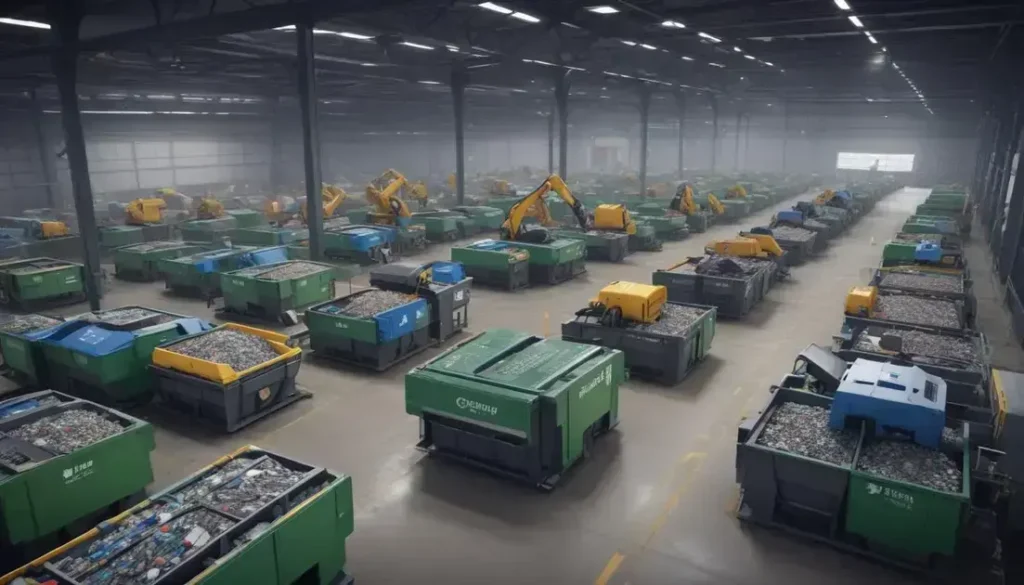Building resilience in the face of climate change involves investing in flexible infrastructure, diversifying supply chains, and engaging local communities to effectively adapt to climate-related challenges and ensure long-term sustainability for businesses.
Climate risk is becoming an undeniable reality for businesses around the world. As UK firms navigate these challenges, understanding the interplay between climate change and operational resilience is crucial.
Understanding physical climate risks
Understanding physical climate risks is crucial for businesses as they assess their vulnerabilities. These risks, resulting from climate change, can manifest in various forms, including extreme weather events, rising sea levels, and temperature fluctuations.
Extreme weather events, such as floods and hurricanes, can disrupt supply chains, damage infrastructure, and lead to significant financial losses. As these occurrences become more frequent, firms must identify potential impacts on their operations and develop strategies to mitigate them.
Additionally, rising sea levels threaten coastal businesses, prompting many to reconsider their locations or invest in protective measures. Temperature fluctuations can also impact productivity and employee health. Companies must be proactive in addressing these challenges to remain resilient.
To effectively manage physical climate risks, organisations should conduct thorough assessments of their exposure. This includes evaluating potential risks to assets, supply chains, and workforce. Moreover, investing in climate-resilient infrastructure and exploring insurance options can further protect against adverse impacts.
Finally, staying informed about local and global climate trends is vital. Collaborating with industry peers and stakeholders can enhance understanding and collectively develop adaptive strategies, ensuring long-term sustainability and viability in a changing environment.
The impact of climate change on global GDP
The impact of climate change on global GDP is a pressing concern for governments and businesses alike. As climate change accelerates, it threatens to disrupt economic stability and growth across the globe.
Extreme weather events, such as floods and droughts, can inflict significant damage on infrastructure and agriculture, leading to reduced productivity. This translates to lower GDP as sectors struggle to recover from severe disruptions. For example, agricultural losses in key regions can lead to a spike in food prices, impacting both consumers and the economy.
Additionally, rising sea levels threaten coastal cities and their economies, resulting in costly relocation efforts and extensive infrastructure repairs. This not only strains public resources but also affects private investments, hindering overall economic growth.
Furthermore, the financial sector faces increasing risks associated with climate change. Insurers may experience higher claims due to climate-related disasters, which can lead to increased premiums and a reluctance to invest in vulnerable industries. This creates a ripple effect throughout the economy.
Adaptation strategies are essential for mitigating these impacts. By investing in sustainable practices and technologies, countries can improve resilience, reduce long-term costs, and safeguard future economic growth. The intersection of climate and economy must be understood for effective policymaking.
Climate adaptation and resilience measures
Climate adaptation and resilience measures are essential for businesses facing the inevitable effects of climate change. These measures help organisations to prepare for, respond to, and recover from climate-related disruptions.
One crucial strategy involves assessing vulnerabilities in operations and supply chains. Businesses can conduct comprehensive risk assessments to identify potential impacts from extreme weather events and other climate risks. This proactive approach allows for the development of targeted adaptation plans that enhance resilience.
Investing in sustainable infrastructure is another key measure. Upgrading facilities to withstand floods, heatwaves, and other climate impacts can save considerable repair costs down the line. For example, flood barriers and green roofs can provide significant protection against adverse weather conditions.
Additionally, fostering partnerships with local governments and communities can enhance resilience. Collaborating on climate action initiatives not only shares resources but also aligns business interests with community needs. This synergy can lead to more effective solutions for climate adaptation.
Training employees on climate resilience strategies can further strengthen an organisation’s capacity to cope with challenges. By empowering staff with knowledge, businesses ensure that everyone is equipped to respond efficiently during climate-related emergencies.
Sector-specific climate risks
Sector-specific climate risks are increasingly impacting businesses across various industries. Each sector faces unique challenges that necessitate tailored strategies for mitigation and adaptation.
The agricultural sector, for instance, is highly vulnerable to climate change due to reliance on weather patterns. Changes in rainfall, increased temperatures, and the frequency of extreme weather events can severely disrupt crop yields and livestock production. Farmers must adopt resilient practices such as crop rotation and drought-resistant crops to combat these risks.
In the energy sector, the shift towards renewable energy sources is critical. However, solar and wind energy production can fluctuate due to climate conditions, impacting energy supply reliability. Companies must invest in technologies that enhance energy storage and improve grid resilience.
Manufacturing industries may face disruptions in supply chains due to extreme weather conditions affecting transportation and logistics. To address this, firms should assess vulnerabilities within their supply chains and explore diversification strategies to enhance resilience.
Financial institutions are also at risk, as climate-related events can lead to increased loan defaults and insurance claims. Understanding these risks is crucial for making informed investment decisions and fostering long-term sustainability.
Long term vs short term climate risks
Long term vs short term climate risks present unique challenges for businesses as they navigate an increasingly uncertain environment. Understanding these differences is crucial for effective risk management and strategic planning.
Short term climate risks typically involve immediate impacts, such as extreme weather events like hurricanes, floods, and heatwaves. These risks can disrupt operations, damage infrastructure, and lead to significant financial losses. Companies must have contingency plans and disaster recovery strategies in place to respond quickly to these threats and minimise disruptions.
In contrast, long term climate risks relate to gradual changes that accumulate over time, leading to more sustained impacts. Rising sea levels, shifting climate patterns, and increased average temperatures can affect resources, supply chains, and market demand. Addressing these risks requires a comprehensive approach, including investments in sustainable practices and climate-resilient infrastructure.
Effective adaptation strategies must balance both short and long term considerations. For example, while a business may need to respond rapidly to a flood, it should also invest in long term infrastructure improvements to mitigate future flooding risks. This dual focus ensures that companies remain resilient and competitive despite the ongoing changes in the climate landscape.
Effects of climate change on value chains
Effects of climate change on value chains are becoming increasingly evident as industries grapple with the implications of environmental disruptions. Disruptions in weather patterns, natural disasters, and resource scarcity directly impact the efficiency and sustainability of supply chains.
Extreme weather events can halt production, damage infrastructure, and lead to significant delays in the delivery of goods. For example, flooding can disrupt transportation routes, causing delays in deliveries. This, in turn, affects inventory management and customer satisfaction, resulting in financial losses.
Moreover, climate change can alter the availability of raw materials. For instance, agricultural products are subject to shifts in climate conditions, affecting crop yields. As a result, companies may face increased costs or scarcity of essential inputs required for production.
Additionally, shifting consumer preferences towards sustainability necessitate changes in how businesses operate. Companies are increasingly expected to adopt sustainable practices throughout their value chains. This includes sourcing materials responsibly, reducing carbon footprints, and ensuring ethical labor practices.
To remain competitive, businesses must proactively address these challenges by investing in climate-resilient strategies. This may involve diversifying supply sources, enhancing logistics and transportation strategies, and integrating sustainability metrics into their operational frameworks.
Investment in sustainable supply chains
Investment in sustainable supply chains is essential for businesses aiming to thrive in a climate-conscious world. By prioritising sustainability, companies can not only enhance their reputation but also improve operational efficiency.
One significant advantage of sustainable supply chains is cost reduction. By investing in energy-efficient technologies and practices, businesses can reduce waste and lower operational costs. For instance, utilising renewable energy sources can significantly cut energy expenses over time.
Moreover, sustainable supply chains attract eco-conscious consumers who prefer brands committed to environmental responsibility. This demand creates opportunities for businesses to differentiate themselves in competitive markets. By showcasing sustainable practices, companies can build consumer loyalty and drive sales.
Additionally, investing in sustainable supply chains enhances resilience against climate-related disruptions. Companies that adopt sustainable practices are better prepared to navigate challenges such as resource scarcity or regulatory changes aimed at reducing carbon emissions.
Collaboration with suppliers is also key to successful sustainable supply chain management. Engaging with suppliers to ensure their practices align with sustainability goals promotes transparency and accountability throughout the supply chain. Such collaborations can lead to innovative solutions that benefit all stakeholders involved.
Adaptation strategies for UK businesses
Adaptation strategies for UK businesses facing climate change are crucial to ensure sustainability and competitiveness. As the impacts of climate change become more pronounced, businesses must proactively develop and implement effective strategies.
One essential strategy involves conducting risk assessments to identify vulnerabilities. This analysis helps businesses understand potential climate-related impacts on operations, supply chains, and financial stability. By knowing their risks, companies can prioritise actions to mitigate them.
Investing in green technologies is another vital adaptation strategy. Transitioning to energy-efficient systems and renewable energy sources not only reduces carbon footprints but also decreases operational costs over time. This shift can enhance a company’s reputation while contributing to national sustainability goals.
Building resilience through flexible supply chains is also key. Businesses can enhance their adaptability by diversifying suppliers and sourcing materials from various regions. This approach reduces reliance on specific markets that may be more susceptible to climate disruptions.
Finally, fostering a culture of sustainability among employees can enhance adaptability. Training and engaging staff in sustainability initiatives empowers them to contribute to the firm’s climate resilience efforts. Emphasising the importance of climate action and sustainability is essential for building a proactive organisational culture.
Case studies on climate risk in supply chains
Case studies on climate risk in supply chains provide valuable insights into how businesses can anticipate and manage the impacts of climate change. These real-world examples highlight both vulnerabilities and successful strategies across various industries.
For instance, a leading agricultural firm faced significant disruptions due to changing weather patterns that affected crop yields. In response, the company invested in climate-resilient farming techniques, such as drought-resistant crops and advanced irrigation systems. This proactive approach not only mitigated losses but also improved overall productivity.
In the textile industry, a major brand experienced supply chain interruptions following severe flooding in key manufacturing regions. The company responded by diversifying its supplier base and implementing a risk management framework that evaluated geographical vulnerabilities. This strategy reduced dependency on any one region and enhanced the resilience of its supply chain.
Another notable case involves a technology company that incorporated sustainability into its production processes. By engaging with suppliers on environmental best practices, it effectively reduced its carbon footprint while ensuring a steady supply of materials. The partnership fostered innovation and long-term sustainability.
These case studies illustrate that adapting to climate risk is not just a challenge but an opportunity for businesses. Learning from these examples can help firms design effective strategies that support resilience in their supply chains.
Implications for the financial and manufacturing sectors
Implications for the financial and manufacturing sectors regarding climate change are profound and multifaceted. Both industries face unprecedented challenges that demand immediate attention and strategic adaptation.
In the financial sector, climate risks present significant issues for investment strategies and risk assessment. Financial institutions must account for the potential impacts of climate change on their portfolios. This includes evaluating the sustainability of investments and the long-term viability of companies exposed to climate-related liabilities. Failure to do so can lead to severe financial losses and reputational damage.
Moreover, regulatory pressures are increasing. Governments and international bodies are pushing for greater transparency regarding climate-related financial disclosures. This trend compels financial institutions to adopt more rigorous reporting standards to mitigate risks and ensure compliance. Consequently, firms that proactively adapt to these regulations will likely gain a competitive advantage.
For the manufacturing sector, climate change poses operational risks, such as supply chain disruptions caused by extreme weather events. Manufacturers must invest in resilient infrastructure and sustainable practices to safeguard their operations against these disruptions. This includes sourcing materials responsibly and incorporating energy-efficient technologies into production processes.
Ultimately, both sectors must recognise that proactive adaptation to climate change can lead to innovation and long-term sustainability. By embracing these challenges, they can position themselves for success in an increasingly uncertain future.
The role of innovation in adaptation
The role of innovation in adaptation to climate change is pivotal for businesses seeking long-term sustainability. As environmental challenges escalate, innovative solutions are necessary to enhance resilience and reduce vulnerabilities.
One significant area of innovation is the development of green technologies. These technologies, such as renewable energy sources—solar, wind, and bioenergy—enable businesses to decrease their carbon footprint while ensuring a reliable power supply. By adopting these technologies, companies can not only lower operational costs but also comply with increasing regulatory standards related to emissions.
Moreover, innovation in product design is essential for sustainability. Companies are now creating products that use fewer resources and are easier to recycle. This shift not only appeals to environmentally conscious consumers but also reduces waste and boosts efficiency across value chains.
Digital transformation represents another avenue for adaptation. Technologies like artificial intelligence (AI) and big data analytics enhance decision-making related to risk management. Businesses can analyse vast datasets to forecast climate impacts, enabling them to make informed strategic choices that safeguard their operations.
Additionally, fostering a culture of innovation within organisations empowers employees to contribute ideas that can drive sustainable practices. Engaging teams in sustainability initiatives ensures that adaptation strategies are well-informed and widely supported throughout the organisation.
R&D and customer support in climate resilience
R&D and customer support in climate resilience play critical roles in shaping how businesses adapt to the challenges posed by climate change. Investment in research and development (R&D) enables organisations to discover innovative solutions that enhance sustainability and operational efficiency.
R&D initiatives can lead to the creation of new products and services that are not only environmentally friendly but also cater to the evolving needs of a climate-conscious market. For example, developing energy-efficient technologies or materials that reduce carbon footprints can significantly contribute to a business’s competitiveness in a constantly changing landscape.
Moreover, incorporating customer feedback into R&D processes is essential. By engaging with customers, companies can gain valuable insights into their preferences and concerns regarding climate-related issues. This not only helps in refining products but also strengthens the relationship between businesses and their clients, fostering loyalty and trust.
Customer support teams also play a vital role in climate resilience by providing guidance and assistance related to sustainable practices. Educating customers on how to utilise products in an environmentally friendly manner or suggesting alternatives can enhance customer satisfaction while promoting sustainability.
Ultimately, integrating R&D with robust customer support strategies ensures that businesses are well-equipped to tackle climate challenges while meeting customer expectations and contributing to a more sustainable future.
Building resilience in the face of climate change
Building resilience in the face of climate change is imperative for businesses aiming to thrive in an increasingly unpredictable environment. Resilience involves the ability to adapt to and recover from climate-related challenges while maintaining operational continuity.
One effective approach to building resilience is investing in flexible infrastructure. This includes retrofitting existing buildings to withstand extreme weather events, such as floods and storms. Companies can incorporate sustainable design principles to reduce vulnerability, ensuring that their facilities are equipped to handle changing climate conditions.
Additionally, diversifying supply chains is crucial for resilience. By sourcing materials and products from a variety of suppliers and regions, businesses can mitigate risks associated with disruptions caused by climate events. This strategy allows companies to adapt swiftly if a particular source becomes compromised due to adverse weather.
Engaging with local communities and stakeholders also fosters resilience. Collaborating on climate initiatives can enhance understanding of regional climate risks while leveraging local knowledge to implement effective adaptation measures. This community approach not only strengthens relationships but also promotes shared responsibility in tackling climate challenges.
Finally, incorporating climate risk assessments into strategic planning is essential. Regularly evaluating potential climate impacts enables businesses to anticipate risks and develop proactive measures that bolster resilience, ensuring long-term sustainability in the face of climate change.
In conclusion, embracing climate resilience is essential for businesses today
As climate change continues to affect industries worldwide, it is crucial for companies to develop strong adaptation strategies. Investing in flexible infrastructure, diversifying supply chains, and engaging with local communities can significantly enhance resilience.
Moreover, integrating climate risk assessments into strategic planning allows businesses to stay ahead of potential challenges. By prioritising innovation and sustainability, organisations can thrive in an uncertain future.
Ultimately, addressing climate risks not only protects businesses but also contributes to a healthier planet. Therefore, companies must take proactive steps now to ensure long-term success and sustainability.
Frequently Asked Questions
How can businesses build resilience against climate change?
Businesses can build resilience by investing in flexible infrastructure, diversifying supply chains, and engaging with local communities to foster collaboration.
What role does innovation play in climate resilience?
Innovation is key as it leads to the development of sustainable products and solutions that help businesses adapt to climate challenges effectively.
How important is customer feedback in sustainability initiatives?
Customer feedback is vital as it provides insights into consumer preferences and helps shape products and services that align with sustainability goals.
What are climate risk assessments, and why are they necessary?
Climate risk assessments evaluate potential climate-related threats to a business, enabling proactive measures to mitigate these risks in strategic planning.
How can renewable energy impact a business’s sustainability efforts?
Utilising renewable energy sources reduces carbon footprints, lowers operational costs, and enhances a company’s reputation as a sustainable player in the market.
What can companies do to engage local communities in their sustainability efforts?
Companies can collaborate on climate initiatives, promote local awareness campaigns, and involve community members in sustainability projects to enhance local impact and support.


